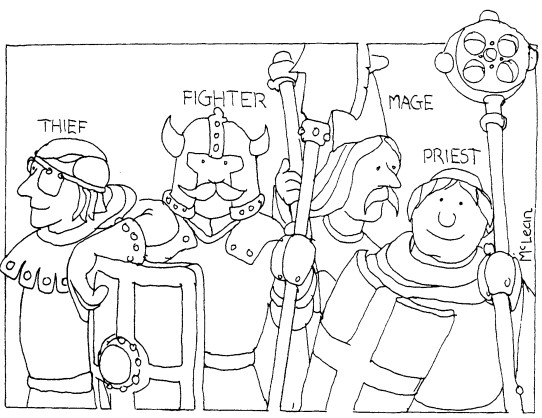
CHARACTER CLASSES (Descriptions, Functions, Levels)

Character class refers to the profession
of the player character. The
approach you wish to take to the game,
how you believe you can most
successfully meet the challenges which
it poses, and which role you desire
to play are dictated by character class
(or multi-class).
Clerics principally
function as supportive, although they
have some offensive spell power
and are able to use armor and weapons
effectively. Druids are a sub-class
of cleric who operate much as do other
clerics, but they are less able in
combat and more effective in wilderness
situations.
Fighters generally
seek to engage in hand-to-hand combat,
for they have more hit points and
better weaponry in general than do other
classes. Paladins are fighters <UA: revise>
who are lawful good (see
ALIGNMENT).
At higher levels they gain limited
clerical powers as well. Rangers are another
sub-class of fighter. They are
quite powerful in combat, and ot upper
levels gain druidic and magic spell
usage of a limited sort.
Magic-users cannot expect to do well in
hand-to-hand
combat, but they have a great number of
magic spells of offensive,
defensive, and informational nature. They
use magic almost exclusively to
solve problems posed by the game. Illusionists
are a sub-class of magic-user,
and they are different primarily because
of the kinds of spells they
use.
Thieves use cunning, nimbleness, and stealth.
Assassins, a sub-class of
thief, are quiet killers of evil nature.
Monks are aesthetic disciples of
bodily training and combat with bare hands.
Each class is detailed fully in
succeeding paragraphs. It is up to you
to select what class you desire your
character to be. Selection must be modified
by abilities generated and
possibly by the race of your character.
The following tables will enable you to
determine the major differences
between character classes at a glance.
Specific comparisons must be done
in {light} of the detailed info given
in the sections which discuss the
individual classes in question. Note that
non-human and semi-human race
characters who are multi-classed
are typically bound by the limitations of
the thief class only. That is, a fighterlmagic-user
can benefit from both
armor, weaponry and spells; a fighter/thief
is limited by the constraints of
the thief class.

Q. Are the anti-paladin,
anti-ranger,
samurai and houri character
classes
officially part of the AD&D
game?
A. No. Although many
new character
classes have been published
over the
years, very few have made
it to
official status. The
ranger, for example,
began as an article in 1
of
the very early issues of
Strategic
Review (a precursor
of DRAGON
magazine), and was incorporated
into the official AD&D
Game when
the Players Handbook
was published.
Other
than the barbarian (in #2 of
IMAGINE magazine),
the thief -acrobat
(#6), and the cavalier (#11)
there have been no official
character
classes since the Players
Handbook
was published. This
has not stopped
the flood of unofficial
material, much
of which has been quite
interesting.
Many players find that the
classes in
the Players Handbook
do not serve
the needs of their own campaign,
which might, for example,
feature a
very powerful evil religion,
of which
anti-paladins might be a
part.
However,
many of the character
classes are attempts to
produce
super-powerful characters,
allowing
some players to unbalance
The Game
-- the ninja (an assassin
variant
based upon the medieval
Japanese
spies and Killers) was particularly
easy to exploit in this
manner.
There
are 2 other points to note
in connection with unofficial
character
classes. Firstly,
many DMs may
not allow such characters
into their
campaigns because they do
not know
the roolz governing those
characters
-- every DM knows how a
fighter
'works', but how many know
the
details of the merchant
or the toady?
Secondly, while they may
not be
completely suitable for
PCs,
unofficial classes make
interesting
NPCs for parties to encounter.
<update, OA: the samurai
is an official class>
(Imagine #14)
Q. If a character
with a STR of 10
finds a girdle of giant
strength, can
he become a ranger, which
has a minimum STR requirement
of 13?
A. No. Character
class prerequisites
apply to the unaugumented
permannent
abilities of a character.
Abilities
that are boosted above the
required
minimum only while items
such as
gauntlets, rings and girdles
are in the
character's possession do
not count;
the augumentation is temporary,
lasting
only as long as the item
is worn.
Of course, for characters
who read
manuals & tomes -- or
use wishes
-- to increase their abilities
permanently,
these restrictions do not
apply
when they enter
a new class (see
PHB p33), as their
natural abilities
have been improved for good,
without
the temporary aid of artificial
devices which withdraw their
benefits
when no longer worn etc.
A similar
point should also be
made about the D&D
Game -- it is the
character's unaugumented
abilities
that count when determining
if a
class is a good choice for
that
character, so players cannot
claim
their brand new character
just
happened to inherit daddy's
girdle of
giant strength.
(Imagine #26)
CHARACTER CLASSES TABLE I: HIT DICE, SPELL ABILITY, AND CLASS LEVEL LIMIT
| Class of Character | Hit Die Type | Maximum Number of
Hit Dice |
Spell Ability | Class Level Limit |
| CAVALIER | d101 | 10 | no | none |
| Paladin | d101 | 9 | yes2 | none |
| CLERIC | d8 | 9 | yes | none |
| Druid | d8 | 14 | yes | 23 (Hierophant of the Cabal) |
| FIGHTER | d10 | 9 | no | no |
| Barbarian | d12 | 8 | no | no |
| Ranger | d83 | 10 ( +1)3 | yes4 | none |
| MAGIC-USER | d4 | 11 | yes | none |
| Illusionist | d4 | 10 | yes | none |
| THIEF | d6 | 10 | no5 | none |
| Acrobat | d6 | 12 | no | none |
| Assassin | d6 | 15 | no5 | 15 (Grandfather of Assassins) |
| MONK | d46 | 17 ( +1)6 | no | 17 (Grand Master of Flowers) |
| BARD | d6 | 10 | yes | 23 (Master Bard 23rd) |
CHARACTER CLASSES TABLE II: ARMOR AND WEAPONS PERMITTED
| Class of Character | Armor | Shield | Weapons | Oil | Poison |
| CAVALIER | any1 | any | any1 | no2 | only if evil |
| Paladin | any1 | any | any1 | no2 | never |
| CLERIC | any | any | club, flail, hammer, mace, staff, lasso, sap, <sling: A0.65>, staff sling | yes | only if evil |
| Druid | leather or padded | wooden | aklys, club, dagger, dart, garrot, hammer, lasso, sap, sling, scimitar, spear, staff, staff sling, sword (khopesh), whip | yes | DM's option |
| FIGHTER | any | any | any * | yes | DM's option |
| Barbarian | any3 | any | any | yes | DM's option |
| Ranger | any | any | any | yes | DM's option |
| MAGIC-USER | none | none | caltrop, dagger, dart, knife, sling, staff | yes | DM's option |
| Illusionist | none | none | caltrop, dagger, dart, knife, sling, staff | yes | DM's option |
| THIEF | leather, studded leather, padded, or elfin chain4 | none | bow (short), caltrop, club, crossbow (hand), dagger, dart, garrot, knife, sap, sling, sword (broad), sword (falchion), sword (long), sword (short) | yes | DM's option |
| Acrobat | as thief | none | as thief, plus lass and staff | yes | DM's option |
| Assassin | as thief | none | any | yes | yes |
| MONK | none | none | aklys, atlatl, axe (hand), bo stick, caltrop, club, crossbow (any), dagger, garrot, javelin, jo stick, knife, lasso, pole arm (any), sap, spear, staff, sword (falchion) | no | DM's option |
| BARD | leather, studded leather, padded, ring mail, elfin chain, or magical chain mail | none | club, dagger, dart, garrot, javelin, knife, lasso, sap, scimitar, sling, spear, staff, sword (bastard), sword (broad), sword (falchion), sword (long), sword (short) | yes | only if evil |
* (You may, at your option, allow fighters
to opt to learn various artillery engines in lieu of normal hand weapons.)
<above note was take from siege weapons
section of the DMG>
1: A cavalier or a paladin
will not wear leather, padded, or studded leather armor, because
such garb is considered beneath the character's station. Similarly,
a cavalier or paladin will
not USE pole arms, missile weapons, or other types of arms that are associated
with the lower social classes. <Knights of Solamnia may be exempt from
this>
See the description of the
cavalier class hereafter for particulars.
2: The USE of oil in personal combat is unacceptable to the cavalier and the paladin, but such characters may use oil in siege warfare.
3: A barbarian may use any
sort of armor, but does not gain the full benefit of the dexterity bonus
of the class if the armor worn is of the bulky or
fairly bulky category.
4: A thief attired in anything
other than leather armor must take adjustments to his or her chances of
success in performing certain
thieving functions. See
Thieves
Table II hereafter.
ADQ: The Players
Handbook specifically
states that a thief may
use a club, dagger,
dart, sling, or a sword.
Why can't a thief
use a bow?
ADA: It is all a
matter of game balance.
Logically, a DM can say
that a thief's
training takes place in
towns where a
bow on one's back is not
as useful as a
dagger in one's hand when
going into dark
alleys and the like.
(Polyhedron #14)
Q. Some classes have minimum
abiliity
scores such as the ranger
who must
have a STR of 13, INT of
13,
WIS of 14 and a CON of 14.
What happens when a score
drops below the minimum,
as occurs
to CON after a number of
deaths and resurrections,
or STR
if hit in combat by a shadow??
A. The character does not
cease to be a
member of a particular class
(either
temporarily or permanently)
because
his ability scores no longer
reach the
minima required. The minima
apply
only at the time a character
is
created, not to his or her
continued
functioning.
(Imagine #3)


Cavalier +
Paladin +
Cleric +
Druid +
Fighter +
Barbarian +
Ranger +
Magic-User +
Illusionist +
Thief +
Assassin +
Monk +
Bard +
Samurai +
Shukenja +
Sohei +
Bushi +
Kensai +
Oriental Barbarian +
Wu Jen +
Ninja +
Yakuza +
Good Priest +
Neutral Priest +
Evil Priest +
Knight of the Crown +
Knight of the Sword +
Knight of the Rose +
White Magician +
Red Magician +
Black Magician +
Tinker +